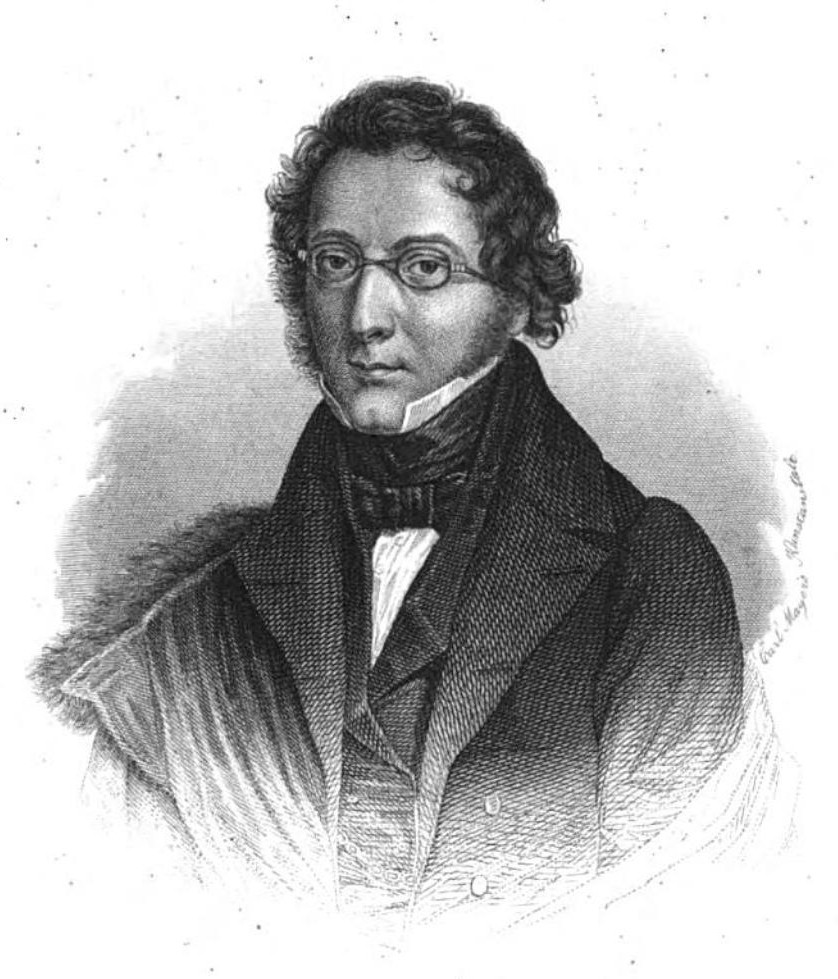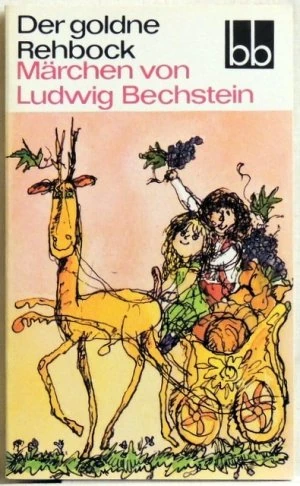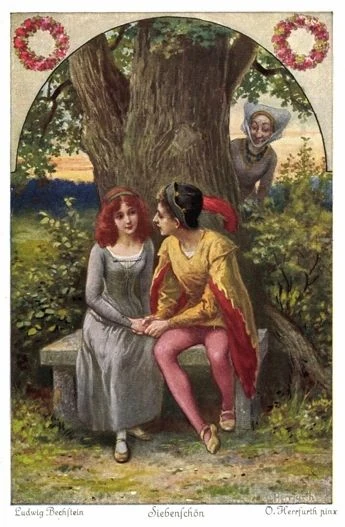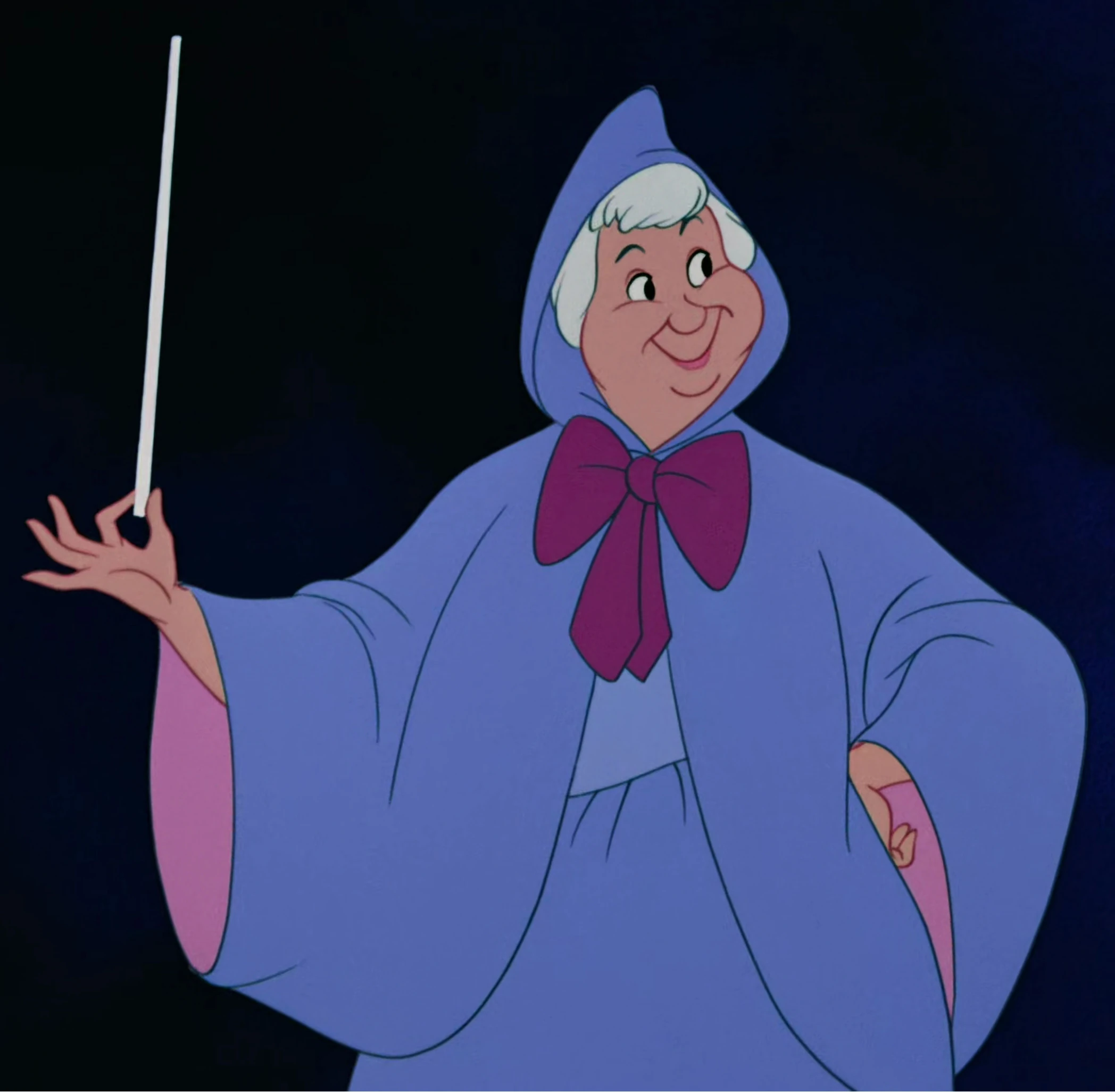Germany is probably one of the most influential countries in what concerns fairy tales and folk tales, alongside Italy, France and the United Kingdom. But despite how much I love the fairy tales by the brothers Grimm, and how much I'm the first to admit their work is a huge part of what made Germany so influential, I always think the folk tales collected by other authors get unjustly overshadowed. So I'll try to give some spotlight to those underappreciated collectors and some of the gems they collected.
We should start with Ludwig Bechstein (1801-1860), whom in his native Germany doesn't get too overshadowed by the brothers Grimm. Internationally... well, that's another tune. My absolute favorite folk tale collected by him is Little Broomstick (Besenstielchen), first published in 1845 in the first edition of his collection The Book of German Tales (Deutsches Märchenbuch), although in the next editions the tales got omitted. It's a Beauty and the Beast tale, in which Beauty, called here Nettchen, has a broom maker's daughter for a best friend. When it's time for Nettchen to go with the Beast, her father thinks he can cheat the Beast giving him his daughter's best friend, but the Beast discovers the scheme, and in the end Nettchen has to go live with the Beast. The spell is broken before Nettchen returns home, and she does it no tonly because her father is sick, but because in the prince's garden there's a plant whose sap is the only medicine that can cure him. In this version Beauty's sisters are definetely next level nasty, because instead of plotting to make Nettchen stay longer thinking that the Beast will get mad at her and kill her, they downight kill her sister, drowing her in the bathtub. Luckily a sorceress, the same one that bewitched the prince, brings her back to life, and because she judges the two sisters to be too dangerous to keep alive, but Nettchen asks her not to kill them, she turns them into stone.
Another one of my favorite tales collected by Bechstein, that unlike the previous one he kept it on the next editions of The Book of German Tales is The Golden Roebuck (Der goldene Rehbock). It tells the story of two orphaned siblings, called Hans and Gretchen, who end up as servants in a house owned by a cannibal and his wife. Everyday they must sweep the floors of eleven of the twelve rooms the house has, while they're forbid to enter the twelfth room. But one day while the cannibals are not at home Gretchen takes a quick peep by the keyhole, and sees inside the titular golden roebuck with a golden carriage. The siblings escape with the roebuck, but the cannibal and his wife go after them. Initially Gretchen deceives them turning herself, her brother and the roebuck in rosebush, and latter they encounter an oven, a pear tree and a grapevine, who ask them to take the bread out, shake its branches so its fruits would fall and pick its grapes respectively. Finally the siblings get rid of the cannibal and his wife with the help of some ducks in a pond. One thing I like about this tales it's that regards female curiosity instead of punishing it. Other tales I love from Bechstein's first collection are The Enchantress Princess (similar to Grimm's Queen Bee, but with two brothers instead of three, and sons of a craftsman instead of a king), The Magic Swan (similar to Grimm's Golden Goose, but with the donor being female instead of male, and explicitely saying that the hero, called here Gottfried, goes intentionally to make the princess laugh), Gold-Maria and Pitch-Maria (similar to Grimm's Frau Holle, but with a male donor instead of a female one), The Boys with the Little Gold Stars, Casting Spells and The Old Wizard and his Children.
Like I previously mentioned, like the brothers Grimm did Bechstein changed some things in his first collection in the next editions, omitting some tales, but also adding new ones. Most of the new ones weren't originally collected by Bechstein himself, but instead by Karl Müllenhoff (1818-1884). Müllenhoff's tales came from Mecklenburg, in northern Germany. Of the new additions my favourites are The Man Without a Heart (Der Mann ohne Herz), that most people probably know because it was included in Andrew Lang's Pink Fairy Book, that tells the story of how the youngest of seven brothers kills the warlock that turned his elder brothers to stone with the help of a bull, a boar and a griffin; and As-Pretty-as-Seven (Siebenschön), a star-crossed love story between a prince and a commoner's daughter with a happy ending.
The Book of German Tales wasn't the only collection Bechstein's published, because some years later, in 1856, he published The New Book of German Tales (Neues Deutsches Märchenbuch). That new book incluede even more tales that weren't originally collected by Bechstein, but instead they were already published in other author's collections. One of my favorites in this one is Cinder Blower with the Wishing Wand (Aschenpüster with the Wishing Wand), a Donkey Skin/All-Kinds-of-Fur variant in which the heroine doesn't runaway from home because her own father wants to marry her, but instead her father before dying lost all of his fortune to gave her everything she wants, included a magic wand. After her father's death the heroine has to work at the palace's kitchen, and she uses the magic wand her father gaver her before he died to go to the ball where the prince falls in love with her. My second favorite is Angela of the Ducats (Das Dukaten-Angele), a tale abou three orphaned sisters, a magic doll that poop coins and the envious married couple the sisters have for neighbours. This is also one of those rare ocasions in which the main character is not the youngest sister and not even the eldest, but the middle one. I can recount many tales in which that's the case besides this one. Can you?
One thing that always noticed of the tales collected by Johann Wilhelm Wolf (1817-1855) is ho few of them have female leads. On his collection you won't find any Cinderella, Snow White, Beauty and the Beast, Donkey Skin, The Wild Swans or Kind and Unkind Girls stories. And I think the lack of female lead stories is exactly what has made his folk tales less known than Grimm's. But that doesn't mind there isn't still some worth checking ones, like The Youth On Fire and the Three Golden Feathers (Der Jüngling im Feuer und die drei goldnen Federn), a story that would be familiar to anyone who has read Grimm's The Devil with the Three Golden Hairs.
Next we go to Hannover, a region in Northeastern Germany bordering with Polland. This region has its own brothers Grimm, called Carl (1812-1855) and Theodor Colshorn (1821-1896). These two brothers collected oral tales exclusively from this region, and some of them don't have anything to be jealous of the Grimm's tales. Like Aschenpöling, the story about a girl who's adopted by a witch that lives in the woods. One day when the girl is grown up the witch leaves her alone at home, forbidding her to open a chamber. The girl does it, of course, and she sees a magic mirror that shows the image of a beautiful maiden with a golden crown at the top of her head. Because she entered the forbidden chamber the witch throws the girl out and she ends up as a scullery maid at the palace's kitchen. The rest of the story is pretty similar to All-Kinds-of-Fur, but at the end, when the girl has married the king, she looks herself in the mirror and discovers that the image she saw in the mirror of the forbidden chamber was her future. My other favourite tale collected by them is a Beauty and the Beast tale, The Clinking Clanking Lowesleaf (Vom klinkesklanken Lowesblatt). In this story is a king and not a merchant the one who asks his three daughters what they want him to brought them from his trip. The youngest daughter asks for a clinking clanking lowesleaf, that the king can't find anywhere, untill a black poddle promises to give him one if the king in exchange agress to give to the poddle the first living creature that greets the king when he arrives at his castle. That first living creature turn out to be his youngest daughter, and by suggestion of the queen the king tries to deceive the poddle, giving him daughters of commoners pretending to be the princess, but the poddle always discovers the truth because he brings the girls under a willow tree where everyone can only say the truth. Finally the king has to let the poddle take his daughter away. The princess is taken to a hut in the middle of the forest, where she feels so alone that wishes for company, even if it's an old beggar woman. Such old beggar woman appears in that exact instant, and in exchange for inviting her to the princess' wedding and letting her sit by her side and drink from her cup the old lady tells the princess how to break the spell. After the spell is broken, at the princess' wedding day the old beggar woman goes to the wedding, where the princess let her sit by her side and drink from her cup. As you can see, this is a Beauty and the Beast story in which the heroine needs to look beyond external appearance when it concerns enchanted princes.
From Northeastern Germany we go to Southwestern Germany. To the region of Swabia to be more specific. Ernst Meier (1813-1866) collected tales from that region, and between my favourites we can found The Three Ravens (Die drei Räben), a story that starts like Grimm's tale of the same name, with a mother cursing her disobedient kids to be turned into ravens, and her sisters goes to search for them. Once she found them the story becomes more similar to The Twelve Brothers and The Six Swans, with the sister having to keep silence for seven years to disenchant her brothers. She's found by a hunter this time instead of a king who marries her, and here the one who gets rid of her newborn children because she hates the heroine is a midwife instead of her mother-in-law. Like in most versions everything turns out okay in the end, with the brothers disenchanted and the sister's innocence proven, but unlike in most of them the sister's husband is judged not to be good enough for her because he beleived the midwife's lies, and she leaves him. Meier also collected a Bluebeard tale, titled King Bluebeard (König Blaubart), in which like its title says Bluebeard is a king; and not just one but two Cinderella tales. In the first one, Aschengrittel, the heroine is given a golden magic wand that will grant her every wish she has when she strikes it against the well's edge, by a white dwarf who gave it to her after seeing the good she had when he offered to grant her six wishes, three good ones and three bad ones, and she rejected her bad ones to be granted.
I suppose I can't end this post without talking about Franz Xaver von Schönwerth's (1811-1886) tales, specially because I own a physical copy of The Turnip Princess and Other Newly Discovered Fairy Tales. I must say that I kinda agree with what Jack Zipes said in an interview, that the media at the time overhyped the collection, and that there's still a lot of great European collections of folktales that haven't got yet the attention they deserve, like the ones by Giuseppe Pitrè or Emmanuel Cosquin, despite some of them being published for centuries by now. But despite that, the collection still has some tales that are worth reading, like The Enchanted Quill (Die Zauberfeder), The Flying Trunk (Das fliegende Kästchen), King Goldenlocks (König Goldhaar), similar to Grimm's Iron Hans; Ashfeathers (Aschenflügel), Schönwerth's own version of Cinderella; The Snake Sister (Schwester Schlange), a tale similar, and I think better than Grimm's White Bride and the Black Bride; The Iron Shoes (Die Eisneschuhe), The Girl and the Cow (Die Prinzessin und die Kuh), The Scorned Princess (Die verschmähte Prinzessin), Three Flowers (Die drei Blumen), The Weasel (Das Wiesel), The Burning Trough (Der feurige Backtrog) and The Talking Bird, the Singing Tree and the Sparkling Stream (Der redende Vogel, der singende Baum und die goldgelbe Quelle).







